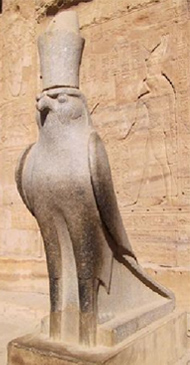| Horus the falcon, is one of Ancient Egypt’s eminent Pharaonic gods, a representative of the sky, deity of the rising sun, symbol of divine kingship, and protector of the ruling king. The son of Isis and Osiris was worshipped as a falcon at the beginning of the pre-dynastic era. |
|
| His right eye is the sun and his left is the moon. His spotted feathers symbolize the stars and his wings are the sky. The name Horus is derived from “Hr” in the Ancient Egyptian language, which means the high or the distant one. |
|
| The goddess Isis conceived Horus after she retrieved all the assembled parts of her dead husband Osiris, who was murdered by his brother Seth. Fearing that Seth would kill her son, she fled to the Delta, where she delivered Horus in the papyrus marshes, thus he was named Horus, meaning “he who is upon his papyrus plants” |
|
| Horus was also the legendary heir to the kingship of Egypt and struggled for the throne of Egypt, while the pharaohs were considered “followers of Horus”. This is demonstrated on the Narmer palette, which dates to the pre-dynastic era and is currently on display at the Egyptian museum. |
|
 |
|
| As a solar deity, Horus was depicted in three different forms: Harakhty Horus of Behdet and Harmachis. Harakhty, or Horus of the Horizon, is the god of the east and the rising sun. Horus of Behdet was represented as a winged solar disc, representing the passage of the sun through the sky. Finally, Harmachis represented Horus as a sun god in falcon or leonine form. Interestingly enough, the sphinx in the Gizaplateau was once worshiped as Harmachis. |

